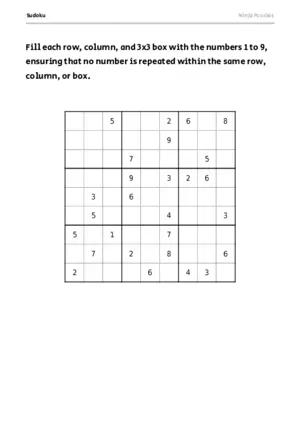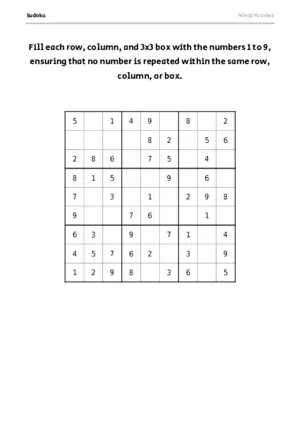Sudoku Strategies and Techniques
Sudoku is a popular number puzzle that challenges and satisfies minds all over the world. Originating in Japan, it has become a global sensation, providing a mental workout that enhances analytical thinking, problem-solving skills, and logical reasoning. To conquer Sudoku puzzles and experience that victorious feeling, you need to use various strategies that gradually unveil its secrets.
🔍 If, after using these tactics you still can’t solve your Sudoku, we have a Sudoku Solver (and a Sudoku Mini Solver) that can help you out.
In this article, we explore different Sudoku strategies, offering effective techniques that can help beginners and experienced solvers tackle even the most difficult grids. We provide step-by-step guidance, from simple methods to advanced maneuvers, equipping you with the tools and insights needed to confidently solve Sudoku puzzles with finesse.
We explain the fundamental strategies that form the foundation of Sudoku mastery, revealing the logical reasoning behind each move and demonstrating their practical applications through examples.
Throughout this journey, we will introduce tactics like the Singleton Technique, Naked Pairs, Sudoku X-Wing, Sudoku Y-Wing, Swordfish, and other powerful methods that unlock the secrets hidden within Sudoku’s 81 squares. You will learn how to eliminate candidate numbers, fill in missing values, and unravel complex patterns to gain a deeper understanding of the puzzle’s structure.
Each strategy has its own purpose, and combining them leads to successful puzzle solving. It’s important to practice and experiment with these techniques to become a skilled Sudoku solver. With time and experience, you will develop the ability to spot patterns and identify opportunities to apply these strategies effectively.
Sudoku Basics
Before we explore the strategies, let’s quickly review the basic rules of Sudoku. The puzzle consists of a 9x9 grid divided into nine 3x3 subgrids. The objective is to fill the empty squares with numbers from 1 to 9 so that each row, column, and subgrid contains every number exactly once.
At the beginning of the puzzle, some squares already have numbers in them, called givens. These givens provide a starting point, and the solver must use logic and reasoning to fill in the remaining squares. The puzzle is considered solved when all squares are filled, and the rules are met.
Some common techiques include:
-
Cross-Referencing: Cross-referencing is a powerful technique in sudoku that involves analyzing the relationships between different cells, rows, columns, and boxes. By examining the possible candidates for a particular number in a given row, column, or box, cross-referencing allows you to identify cells where a number can only appear in one specific location. This technique helps narrow down the possibilities and aids in making more informed deductions throughout the puzzle-solving process.
-
Candidate Elimination: Candidate elimination is a fundamental strategy in sudoku that involves iteratively examining the potential candidates for each empty cell and eliminating possibilities based on the constraints of the puzzle. By analyzing the numbers already present in the same row, column, and box as a particular cell, you can identify candidates that are already taken and eliminate them from consideration. Through a systematic process of elimination, candidate elimination helps to reduce the number of possibilities for each cell, ultimately leading to the correct solution.
-
Logical Deductions: Logical deductions form the backbone of sudoku solving, relying on the application of logical reasoning to make progress in the puzzle. This technique involves carefully analyzing the available numbers in a row, column, or box and deducing the correct placement for a particular number based on the existing information. By considering various possibilities, examining constraints, and identifying patterns, logical deductions allow you to make informed decisions and fill in numbers with certainty. This technique often involves a step-by-step approach and can unlock subsequent deductions as you progress through the puzzle.
We have a complete beginners guide with more tips and techniques for getting started solving sudoku puzzles. If you’re looking for a specific strategy, you can find a list of all our Sudoku strategies below.
Sudoku Solver
If you get really stuck then we have an online Sudoku Solver, and a Sudoku Mini Solver to help you solve the most challenging Sudoku puzzles.
Advanced Sudoku Strategies
- Singleton Technique: This strategy involves identifying squares that have only one possible candidate number based on the numbers already present in the row, column, and box.
- Naked Pairs and Triples: When two or three squares in a unit (row, column, or box) have the same two or three candidate numbers, those numbers can be eliminated as possibilities from other squares in the unit.
- Hidden Pairs and Triples: This strategy focuses on identifying two or three candidate numbers that only appear in the same two or three squares within a unit. These numbers can then be eliminated as possibilities from other squares in the unit.
- Sudoku X-Wing: Sudoku X-Wing involves finding two rows or two columns where the same number can only occur in the same two positions. By eliminating that number as a possibility in the corresponding rows or columns, you can make further deductions.
- Swordfish: Similar to Sudoku X-Wing, Swordfish strategy expands the concept to three rows or three columns. It involves finding three rows or three columns where the same number can only occur in the same three positions, allowing for further eliminations.
- Sudoku Y-Wing: Sudoku Y-Wing is an advanced strategy that involves three cells and three numbers. By utilizing a specific pattern of candidate numbers, you can make deductions that lead to solving other squares.
- Sudoku XYZ-Wing: XYZ-Wing involves three cells and three numbers, with each number belonging to a different candidate list. It allows for deductions by creating chains of eliminations based on the relationships between the three numbers.
- Coloring: This strategy involves assigning colors (usually two) to candidates and using the relationships between these colors to make deductions.
- Backtracking: Backtracking is a brute-force technique that involves making educated guesses and trying different possibilities until a contradiction is reached or the puzzle is solved.








